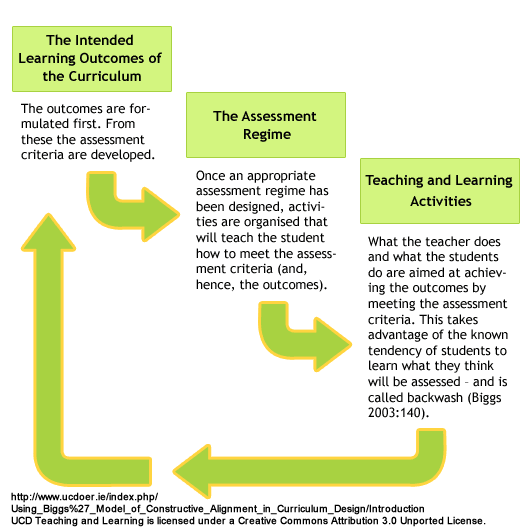Week 2: Overview
Instructional Design Approaches
1. Outcomes-based Learning
In the past, an instructor would be assigned to teach a course and focused first on selecting a textbook and identifying the major topics and concepts that needed to be covered. This often resulted in content-based, transmission model of delivery courses.

Most course outlines in higher education now include learning outcomes (although some still use the language of "objectives") and course design has become "outcomes-based".
An associated concept articulated by John Biggs, an Australian-born professor and writer, referred to the value of making the assessment and teaching strategies coherent with the stated outcomes; this concept is known as "constructive alignment."
An "aligned" curriculum is developed from intended learning outcomes, followed by logically connected learning/teaching activities and assessments (including formative and summative or evaluative instruments). The design process is not linear but an integrated flow that is always measured against the intended outcomes for learners.
This outcomes-based approach is expanded and applied, in many higher education institutions using two well-known approaches to course design:
- Understanding by Design by Grant Wiggins and Jay McTighe provides an outcomes-based approach often referred to as "backwards" design. The UbD framework integrates a focus on the "big" questions or concepts that help an instructor develop curriculum that leads to deeper student understanding and achievement. While design still begins from a focus on the learner, the UbD framework helps designers overcome the perceived limitations of focusing on content or outcome statements alone.
- Integrated Course Design, by Dee Fink focuses on a design process to create "significant learning experiences" for students. His approach involves a unique Taxonomy of Instructional Goals and an Integrated Design Process
You may choose some variation of the outcomes-based approach to learning design. Further sample checklists and links to design tools will be shared during Week 2
References:
Culatta, R. (2015) Transformative Learning (Jack Mezirow) Instructional Design.org. Retrieved from http://www.instructionaldesign.org/theories/transformative-learning.html
Fink, L. Dee (2005). A Self-Directed Guide to Designing Courses for Significant Learning (pdf), Dee Fink & Associates. Retrieved from https://www.deefinkandassociates.com/GuidetoCourseDesignAug05.pdf
Smith, M.K. (2002) 'Malcolm Knowles, informal adult education, self-direction and andragogy', the encyclopedia of informal education, http://infed.org/mobi/malcolm-knowles-informal-adult-education-self-direction-and-andragogy/
University of Alaska Fairbanks, eLearning & Distance Education, iTeachU, Pedagogy Resources: Backward Design, CC BY-NC-SA 4.0, Retrieved Nov 2017 from https://iteachu.uaf.edu/backwardsdesign/
University of Athabasca, Community of Inquiry Model (website). Retrieved from https://coi.athabascau.ca/coi-model/
University College Dublin Teaching and Learning, Using Biggs' Model of Constructive Alignment in Curriculum Design, Becoming a Better University Teacher, Creative Commons 3.0 Unported License. Retrieved from http://www.ucdoer.ie/index.php/Using_Biggs'_Model_of_Constructive_Alignment_in_Curriculum_Design/Introduction
Additional references:
Fallahi, Carolyn (2011) Using Fink's Taxonomy in Course Design, Association for Psychological Science